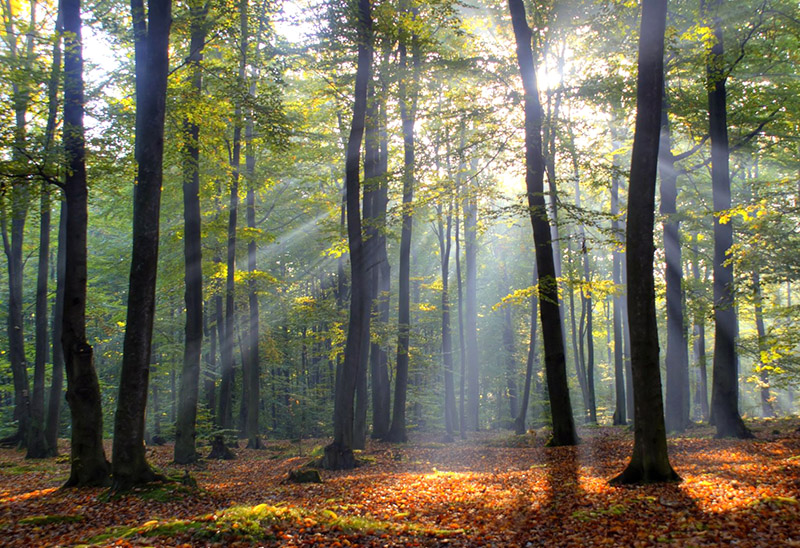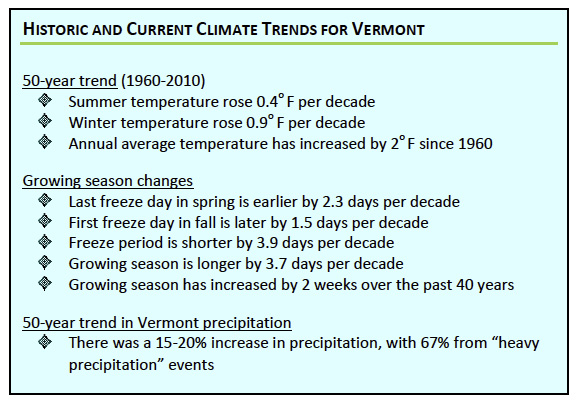| The Impact of Climate Change and Development on Vermont's Forests | |||
| by K.C. Whiteley | |||
When Vermont Woman editor Kate Mueller suggested a column on the health of Vermont's forests. I had no idea how much ground I would cover. Many hours and interviews later, I have a new appreciation for the work our environmental stewards do every day and a deeper understanding of the complexities facing all of us to protect Vermont's revered forests. This column presents the current state of Vermont's forests, how they have changed, and the impact of climate change and development. Next issue we cover what we need to do to keep our precious forests and wildlife habitat healthy and thriving. |
|||
 |
|||
|
First, a quick look at our past. Two hundred and fifty years ago, 90 percent of our state was covered in a vast old-growth forest that disappeared as European deforestation began in the Champlain Valley, opening land for farming, raising sheep, exporting the giant softwoods that made up Vermont's virgin forests, and trapping for furs. Logging became Vermont's largest industry. The 1840 census recorded over 1,000 sawmills in operation. The Connecticut River and Lake Champlain were the primary thoroughfares for transporting logs. When the canal connecting Lake Champlain to the Hudson River was completed in 1823, Burlington became the third busiest port in the country for timber shipping. |
 |
||
By the late 1800s, 70 percent of Vermont was clear-cut, many of our iconic wildlife like white-tailed deer, moose, and beaver were gone, and by 1870, thanks to the shrinking economy, a third of the population had migrated West. As our forests began to recover, fast-growing hardwoods began replacing the softwoods. From the 1940s to the present, our forests "have experienced another wave of wide scale transformation. Human social pressure has brought significant changes as a result of built infrastructure, and Vermont has witnessed the introduction and spread of invasive plant and insect species as well as pathogens" (from Vermont Forest Fragmentation Report, Agency of Natural Resources [ANR], Vermont Department of Forests, Parks and Recreation [FPR], April 2015). Today, Vermont is 75 percent forested, the fourth-most forested state in the US. Eighty percent is owned privately; the remaining 20 percent is public land in the form of state parks and state and some municipal forests. The ANR report points out how the demographics of landowners are changing in significant ways: the number of landowners is increasing, and the size of parcels is decreasing. More people are owning smaller pieces of land. And the age of larger landholders is increasing, making it likely that these larger parcels will be broken up and subdivided as this generation of landowners dies. The ANR report further notes that our rate of development (measured in housing units and developed acres) is growing twice as fast as the state population. Adding to this pressure to develop smaller and smaller residential lots is the fact that most of the population growth is occurring in rural areas. Residential development has increased by 67 percent over the last three decades. The 2013 figures from the US Forest Service National Forest Inventory and Analysis Program show a loss of about 75,000 acres of forestland just since 2007. Projected forestland turnover as the older generation of owners dies out in the coming decade is a central concern. As larger tracts of land become available for development and subdivision, fragmentation will increase.
This brings us to the issue and implications of forest fragmentation. The Vermont Forest Fragmentation Report defines it as the breaking up of "large, contiguous forested areas into smaller pieces of forest, typically by roads, agriculture, utility corridors, subdivisions or other human development … The remnant forest islands that result from fragmentation are surrounded by non-forest lands and land uses that seriously threaten the health, function, and value of those forest islands … In general, fragmentation reduces overall forest health and degrades habitat quality, leading to long-term loss of biodiversity, increases in invasive plants, pests, and pathogens, and a reduction in water quality." Matt Langlais is the Essex and Caledonia County forester for the FPR. He worries that as more people move to Vermont to escape the adverse effects of climate change elsewhere, we may not be able to protect the forest landscape. There is a clear need for more resources to work with new landowners and those aging out. Langlais works with 1,800 landowners covering over 370,000 acres in the current-use program, and the issues are increasingly complex. "We aren't just managing stands of trees, we're talking about climate change, flood resiliency, invasive plants," he said. The impact of fragmentation is more than simple loss of forestland. It also restricts the "connectivity" that allows animals and plants to move about and often introduces nonnative species as a result of development with loss of habitat and biodiversity as a by-product. This connectivity that larger expanses of unbroken forest provide is a major response to climate change that builds natural resilience. The capacity of our forests to adapt to climate change is critical. In its 2015 report, Creating and Maintaining Resilient Forests in Vermont: Adapting Forests to Climate Change, the FPR lays out both the threats to the ecological and economic health of our forests as well as strategies for helping them adapt and stay resilient in the face of existing and inevitable future changes. The effects of rising temperatures on our natural environment are already being observed. The chart "Historic and Current Climate Trends for Vermont" from the 2015 report shows an annual average temperature increase by 2 degrees since 1960. We know the serious threats global warming poses to our skiing and maple sugaring economies and the irreplaceable loss of native species like ash and hemlock as invasive pests and plants make their way north. The value of trees in mitigating climate change is well known. Forests extract carbon from the air and store it. This process, called carbon sequestration, reduces the amount of CO2 in the atmosphere, making it even more important to plant more trees and preserve our forest ecosystems. Mature forests store more carbon below ground than above, the result of long-term accumulation and storage of carbon in soils and root systems. When forest soils become unhealthy or are interfered with, that stored carbon is released back into the atmosphere. Sandy Wilmot is the ANR's forest health specialist and climate change coordinator and the principal author of the aforementioned FPR 2015 report. She has put in 28 years as a forest health specialist in Vermont. Managing the stressors that are affecting our forests is Wilmot's top priority. She names the big three stressors as climate change, air pollution, and invasive plants and pests, all of them influencing each other. Given the inevitability of development and climate change on our forests and overall environment, Wilmot expressed a sense of urgency to diversify our forests to build resilience. We need a diverse variety of ages and types of trees so that, when disturbances like wind events occur, "forests may be damaged initially but can bounce back and maintain a healthy forest cover." She explains the importance of managing forests to get the type of trees you want. One of the trends she finds troubling is what she calls monocultures, like stands of sugar maples that exclude other species. Wilmot points to the increase in aggressive invasive species as a concern that is influenced both by development and by climate change. Because of the lengthening of our growing season, nonnative plants get a head start before native species are out. They use the increase in CO2 to their advantage, growing faster and producing more seeds. Invasive plants also exude chemicals from their roots that prevent other plants from growing near them, resulting in monocultures like the poison parsnip and chervil that are taking over the roadsides. The same thing is happening in our forests with buckthorn, barberry, honeysuckle, and garlic mustard quickly filling in any openings in the woods. The county foresters work with landowners to help them understand the importance of a balance of different species and ages of trees, showing them how the forests are home to many different organisms. Unlike an agricultural crop that can change from year to year, the ecology and life cycle of a forest is much longer. Balancing ecological and economic values can be a challenge. Langlais spends most of his time talking with landowners to help them balance what they want from their property with more long-range interests. He tries to understand their challenges and goals while helping them to understand the overall capacity of their forests and the long-term benefits to the future as thoughtful stewards. The day we spoke, Langlais had spent the morning with a landowner in his late 60s, sitting at the kitchen table in the house he was born in, trying to figure out how to maintain his 175-acre parcel with rising taxes and costs of living. He felt forced into subdividing in order to finance his retirement. "We are a forest-based economy in the Northeast Kingdom," says Langlais. "We've lost two million tons of capacity for low-grade pulp in Maine. Two million tons is a bumper-to-bumper line of fully loaded trucks from Virginia to Quebec on I-95. That's what we've lost, and it's not coming back. There are about 65 skidders for sale on Craigslist right now. We need to think out of the box, think about modern wood heating, realize that depending on oil isn't sustainable." Langlais feels we need to do much more to protect our working forests by enacting changes in tax policy and incentives that value our forests for being forests rather than taxing forestland on its capacity to build houses. We need to expand the state's current-use program in which owners who practice long-term forestry or agriculture are appraised based on the property's value of production of wood or food rather than its residential or commercial development value.
What is happening elsewhere in the US and around the world may forecast what Vermont will contend with in coming years. In The Fate of Trees: How Climate Change May Alter Forests Worldwide published in Rolling Stone magazine (March 2015), author Jeff Tietz reports on the dying out of the conifers in the Southwest. As temperatures rise, dry areas—like the Southwest—are getting drier and heating up faster. These severe droughts are causing "climate-driven episodes of regional-scale forest die-off." Tietz explains that excessive heat causes a tree to lose precious moisture, and it reacts by shutting down photosynthesis, which starves the tree. Insects detect drought stress, and the tree, now defenseless, becomes fodder for them. Hotter climates mean more insects and more intense wildfires, which we have been witnessing for a number of years. Dr. Nate McDowell at Los Alamos National Laboratory in New Mexico claims that "the Southwest is going to be a grassland, with the occasional rare tree. It's going to be a different place. And there's reason to think that's the same for big chunks of the world." Jim Murphy, senior counsel at the National Wildlife Fund chapter based in Montpelier, agrees that climate change is overall the biggest threat to our environment, natural resources, and wildlife. Just as is happening in the Southwest and elsewhere, regeneration cannot keep up with the pace of changes caused by increasing temperatures, drought, and extreme weather events. "If we don't get it under control, we're looking at radical changes in our forests with impacts on wildlife." He sees the potential for an onslaught of pests and invasives that pose a potential collapse of northeastern forest communities as certain native species die out before replacement species come in. Murphy credits Vermont leaders for thinking ahead about how to manage for the future but acknowledges there is only so much a small state like ours can do to bring down global warming. "We have to see some of the things we're doing in New England replicated nationally and internationally."
|
|||
|
K.C. Whiteley is a climate change activist and serves on the 350 Vermont advisory board.
|
||

